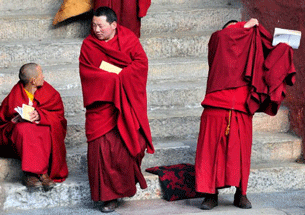Yaks Are Returning to Tibet, but Does Climate Change Pose Further Risks?
By John R. Platt: Wild yaks are coming back to at least one area of Tibet after a long period of overhunting, but the future for the species is yet unknown as their periglacial habitat melts because of climate change.
Wild yaks (Bos mutus) are among Asia’s largest mammals, second only to elephants and rhinos, and are especially adapted to high-altitude regions. The animals were not widely hunted until 50 years ago, when Tibet became an autonomous region of the People’s Republic of China. The change in leadership brought an influx of Chinese settlers who hunted the yaks and took over many of their high-elevation habitats, where humans had not previously settled. The yaks were further pushed aside when pastoralists converted meadows into livestock grazing areas for domesticated yaks (B. grunniens), which are about half the size of their wild counterparts and can transmit diseases to wild herds. According to theIUCN Red List of Threatened Species, wild yaks do not tolerate humans or domesticated animals and move away whenever their habitats are disturbed. By 1996 scientists estimated the total population of wild yaks to be fewer than 15,000 animals.
News of the resurgence in wild yak populations comes through the Wildlife Conservation Society (WCS) and the University of Montana–Missoula (U.M.), which recently counted 990 of the massive beasts in Hoh Xil, a remote glacial reserve the size of West Virginia located in the Qinghai-Tibet Plateau. Although historical population counts for wild yaks are not available, this number appears to be an increase over previous surveys that counted fewer yaks, albeit under different field conditions, says Joel Berger, professor of wildlife conservation at U.M., who led the research expedition. Berger credits the population growth to policies set in place by the Chinese provincial government to protect the beasts from poaching.

Berger and his team were in Tibet to conduct a pilot study examining the importance of
periglacial regions to wild yaks, because the areas near glaciers provide food-rich meadow habitats. A study published last year found that many of the 7,100 glaciers in the Tibetan Plateau are shrinking faster than previously realized; Berger wanted to know how that would impact high-elevation species such as the yaks. “With the recession of glaciers, some higher elevation habitats are being colonized by plants,” he says. This might actually temporarily increase the meadow habitat available for yaks, but he says changing precipitation rates and temperatures will also dry out some regions, making them less hospitable.Berger and his team were in Tibet to conduct a pilot study examining the importance of
As the research continues Berger hopes it will help scientists understand the challenges to conserving wild yaks. Information on the species is sparse; the animals live in such remote regions that they have never been thoroughly studied. “At this point, we do not even know the ages of sexual maturity in females or the frequency in which they have their young. There is much to learn,” he says.
Meanwhile, the possible resurgence of wild yaks could have a positive effect. “Wild yaks serve as an icon for remote and wild,” Berger says. “As China continues its economic growth, local tourism is increasing. Without wildlife, raw and naked landscapes may be pretty but hold little appeal.” He hopes that the wild yaks become a symbol for the conservation of the region, much as the bison did in the American West.
Photo 1: Yak in Tibet by Dmitri Sumin via Flickr. Used under Creative Commons license. (Note: this is probably a domesticated yak.) Photo 2: Wild yaks in Hoh Xil by Joel Berger
About the Author: Twice a week, John Platt shines a light on endangered species from all over the globe, exploring not just why they are dying out but also what's being done to rescue them from oblivion. Follow on Twitter @johnrplatt.


Comments
Post a Comment